This flower whose name everyone knows is rarely seen in Laos. While it is the national flower of Cambodia and the emblem of the province of Sisaket in Thailand, in Laos we speak of it as a flower that was seen in the past but is nowhere to be found. It took us several years to finally be able to photograph a foot of it.
The tree is not very big, about ten meters, and we notice at first its hanging branches. Its leaves are oblong, simple, alternate, and rigid in ageing. Under the leaves, also hanging, appear small flowers of a green-yellow, not very remarkable at first sight; but when we look at them from underneath we are struck by their very “graphic” aspect as if they had been drawn, stylized, so much they are simple, just with three open petals under three petals forming a cap on the sexual organs; these petals are moreover thick, waxy, almost artificial! If we add that dok damdouane has a delicious honey scent that spreads far away in the evening, we can fully understand the reputation of this flower.
In Cambodia, where its name is attested in ancient Khmer and would be the root of the Lao and Thai names, the flower is a symbol of femininity; it participates in several ceremonies, in particular, the “call of the genies”; in 2005 it was declared “national flower”.
In Thailand, dok lamduan is the emblem of a province of Issan, that of Sisaket, and one can attend a festival in March where flowers are everywhere, in garlands, in ephemeral jewellery, in cakes.
In Laos, dok damdouane is much talked about but rarely found; its name is given to little girls and to a pagoda in Vientiane where only a small stunted shrub can be seen; it is mentioned in the literature without being precisely identified; old people say that in the past it was offered at the pagoda but that today you have to go “to the south” to meet it.
Melodorum fruticosum is native to Malaysia and the Indochinese Peninsula, which was visited in the 18th century by a Portuguese monk, João de Loureiro, who gave it its scientific name, “honey smell”; however, this name is still not approved by official botany, as are many others of the same family.
Dok damdouane is not only beautiful, its fruits which become black when ripening are edible; its dried flowers are used in Thailand in the composition of traditional steam baths; they would be a good cardiac tonic, also ridding the body of all its toxins and stimulating the intellectual faculties; many researches are in progress to test these properties
All these reasons should convince you to plant dok damdouane in your garden to enjoy its beauty and fragrance, but also so that such a beautiful flower does not disappear completely from our environment.
Cette fleur dont tout le monde connait le nom est rarement vue au Laos. Alors qu’elle est la fleur nationale du Cambodge, qu’elle est l’emblème de la province de Sisaket en Thaïlande, au Laos on vous en parle comme d’une fleur que l’on voyait autrefois mais qui est introuvable aujourd’hui. En effet, il nous a fallu plusieurs années pour pouvoir en photographier enfin un pied.
L’arbre n’est pas très grand, une dizaine de mètres, et l’on remarque d’abord ses branches pendantes. Ses feuilles sont oblongues, simples, alternes, rigides en vieillissant. Sous les feuilles, pendantes elles aussi, apparaissent de petites fleurs d’un jaune vert, peu remarquables à première vue; mais lorsque on les regarde par en dessous on est frappé par leur aspect très « graphique », comme si elles avaient été dessinées, stylisées, tant elles sont simples, juste avec trois pétales ouverts sous trois pétales formant capuchon sur les organes sexuels; ces pétales sont en outre épais, cireux, presqu’artificiels ! Si l’on ajoute que dok damdouane a un délicieux parfum de miel qui se répand au loin le soir, on comprend tout à fait la réputation de cette fleur.
Au Cambodge où son nom est attesté en ancien khmer et serait la racine des noms lao et thaï, la fleur est symbole de la féminité; elle participe à plusieurs cérémonies en particulier l’ « appel des génies »; en 2005 elle a été déclarée « fleur nationale ».
En Thaïlande, dok lamduan est l’emblème d’une province de l’Issan, celle de Sisaket, et l’on peut assister au mois de mars à un festival où les fleurs sont partout, en guirlandes, en bijoux éphémères, en gâteaux.
Au Laos on parle beaucoup de dok damdouane, mais on ne la trouve que très rarement; son nom est donné aux petites filles et à une pagode à Vientiane où l’on ne peut voir qu’un petit arbuste rabougri; elle est citée dans la littérature sans être précisément identifiée; les vieilles personnes racontent qu’autrefois on l’offrait à la pagode mais qu’aujourd’hui il faut aller « dans le sud » pour la rencontrer.
Melodorum fruticosum est pourtant originaire de Malaisie et de la Péninsule indochinoise visitée au XVIIIème siècle par un moine portugais João de Loureiro qui lui a donné son nom scientifique « odeur de miel »; cependant ce nom n’est toujours pas homologué par la botanique officielle, comme de nombreux autres de la même famille d’ailleurs.
Dok damdouane n’est pas seulement belle, ses fruits qui deviennent noirs en mûrissant sont comestibles; ses fleurs séchées entrent en Thaïlande dans la composition des bains de vapeur traditionnels; elles seraient un bon tonique cardiaque, débarrassant aussi le corps de toutes ses toxines et stimulant les facultés intellectuelles; de nombreuses recherches sont en cours pour tester ces propriétés.
Toutes ces raisons devraient vous convaincre de planter dok damdouane dans votre jardin pour profiter de sa beauté et de son parfum, mais aussi pour qu’une aussi jolie fleur ne disparaisse pas complétement de notre environnent.
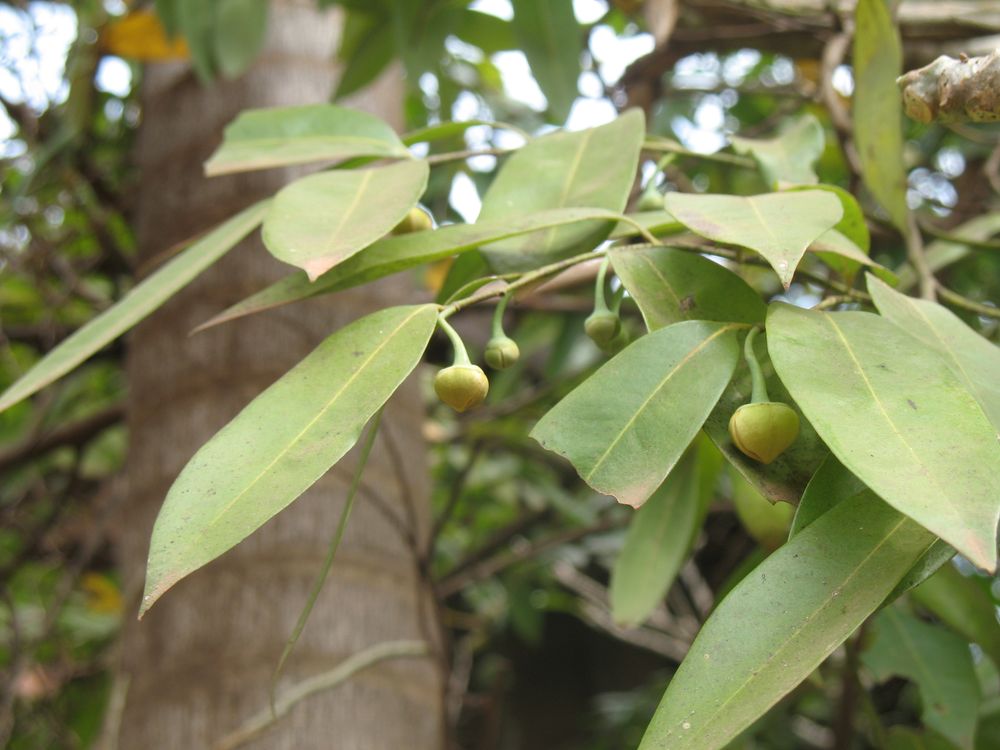
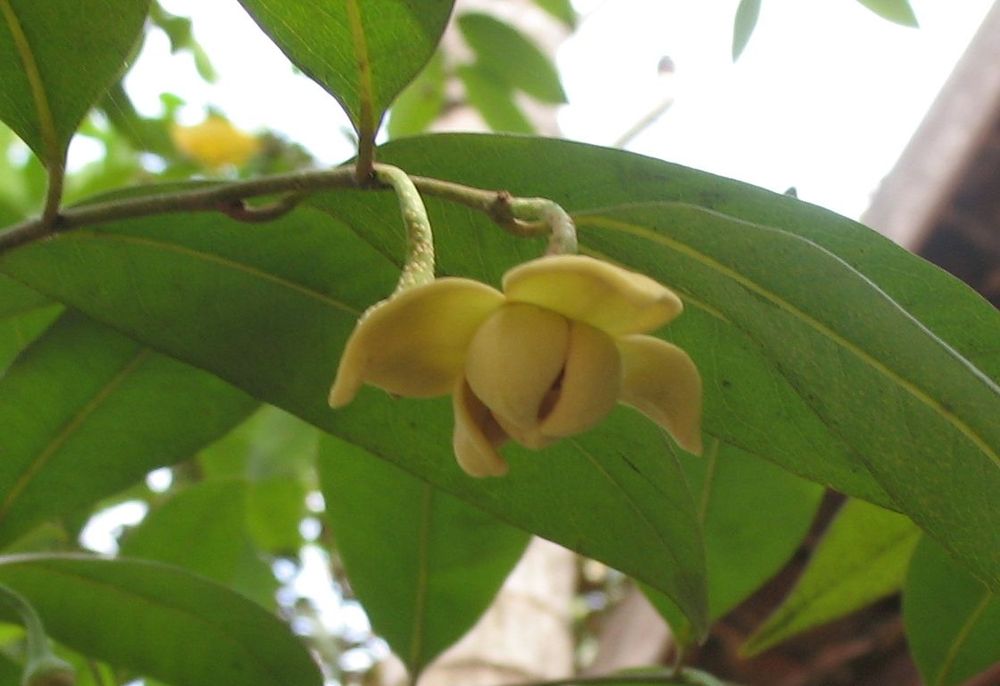
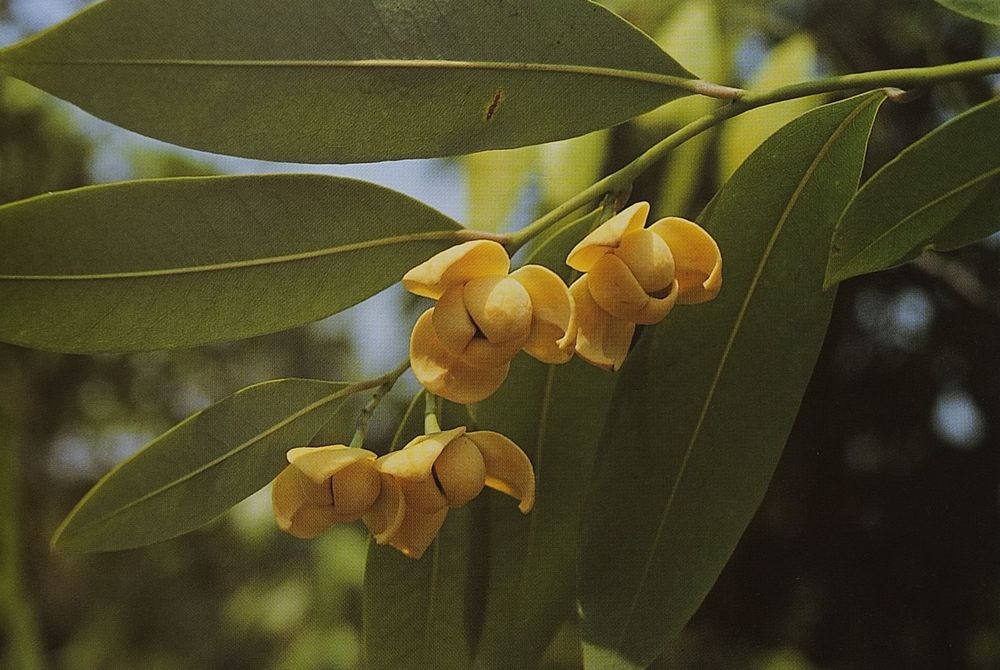
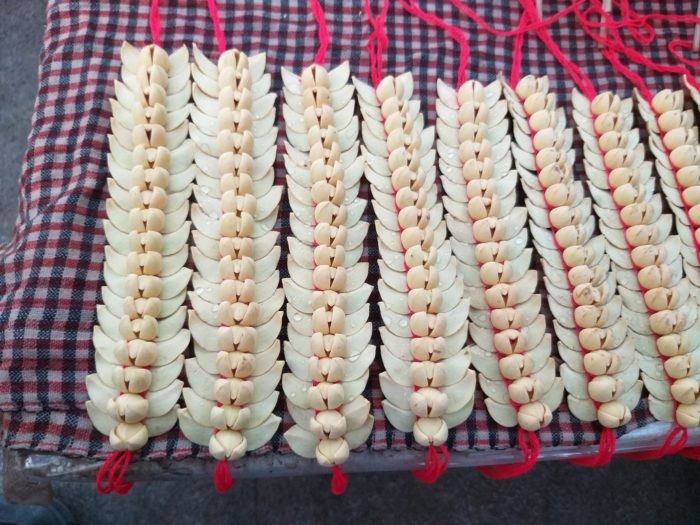
© Photo Tela botanica
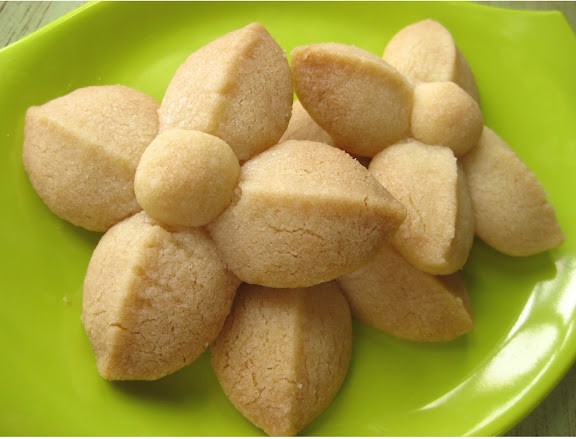
This flower whose name everyone knows is rarely seen in Laos. While it is the national flower of Cambodia and the emblem of the province of Sisaket in Thailand, in Laos we speak of it as a flower that was seen in the past but is nowhere to be found. It took us several years to finally be able to photograph a foot of it.
The tree is not very big, about ten meters, and we notice at first its hanging branches. Its leaves are oblong, simple, alternate, and rigid in ageing. Under the leaves, also hanging, appear small flowers of a green-yellow, not very remarkable at first sight; but when we look at them from underneath we are struck by their very “graphic” aspect as if they had been drawn, stylized, so much they are simple, just with three open petals under three petals forming a cap on the sexual organs; these petals are moreover thick, waxy, almost artificial! If we add that dok damdouane has a delicious honey scent that spreads far away in the evening, we can fully understand the reputation of this flower.
In Cambodia, where its name is attested in ancient Khmer and would be the root of the Lao and Thai names, the flower is a symbol of femininity; it participates in several ceremonies, in particular, the “call of the genies”; in 2005 it was declared “national flower”.
In Thailand, dok lamduan is the emblem of a province of Issan, that of Sisaket, and one can attend a festival in March where flowers are everywhere, in garlands, in ephemeral jewellery, in cakes.
In Laos, dok damdouane is much talked about but rarely found; its name is given to little girls and to a pagoda in Vientiane where only a small stunted shrub can be seen; it is mentioned in the literature without being precisely identified; old people say that in the past it was offered at the pagoda but that today you have to go “to the south” to meet it.
Melodorum fruticosum is native to Malaysia and the Indochinese Peninsula, which was visited in the 18th century by a Portuguese monk, João de Loureiro, who gave it its scientific name, “honey smell”; however, this name is still not approved by official botany, as are many others of the same family.
Dok damdouane is not only beautiful, its fruits which become black when ripening are edible; its dried flowers are used in Thailand in the composition of traditional steam baths; they would be a good cardiac tonic, also ridding the body of all its toxins and stimulating the intellectual faculties; many researches are in progress to test these properties
All these reasons should convince you to plant dok damdouane in your garden to enjoy its beauty and fragrance, but also so that such a beautiful flower does not disappear completely from our environment.
Cette fleur dont tout le monde connait le nom est rarement vue au Laos. Alors qu’elle est la fleur nationale du Cambodge, qu’elle est l’emblème de la province de Sisaket en Thaïlande, au Laos on vous en parle comme d’une fleur que l’on voyait autrefois mais qui est introuvable aujourd’hui. En effet, il nous a fallu plusieurs années pour pouvoir en photographier enfin un pied.
L’arbre n’est pas très grand, une dizaine de mètres, et l’on remarque d’abord ses branches pendantes. Ses feuilles sont oblongues, simples, alternes, rigides en vieillissant. Sous les feuilles, pendantes elles aussi, apparaissent de petites fleurs d’un jaune vert, peu remarquables à première vue; mais lorsque on les regarde par en dessous on est frappé par leur aspect très « graphique », comme si elles avaient été dessinées, stylisées, tant elles sont simples, juste avec trois pétales ouverts sous trois pétales formant capuchon sur les organes sexuels; ces pétales sont en outre épais, cireux, presqu’artificiels ! Si l’on ajoute que dok damdouane a un délicieux parfum de miel qui se répand au loin le soir, on comprend tout à fait la réputation de cette fleur.
Au Cambodge où son nom est attesté en ancien khmer et serait la racine des noms lao et thaï, la fleur est symbole de la féminité; elle participe à plusieurs cérémonies en particulier l’ « appel des génies »; en 2005 elle a été déclarée « fleur nationale ».
En Thaïlande, dok lamduan est l’emblème d’une province de l’Issan, celle de Sisaket, et l’on peut assister au mois de mars à un festival où les fleurs sont partout, en guirlandes, en bijoux éphémères, en gâteaux.
Au Laos on parle beaucoup de dok damdouane, mais on ne la trouve que très rarement; son nom est donné aux petites filles et à une pagode à Vientiane où l’on ne peut voir qu’un petit arbuste rabougri; elle est citée dans la littérature sans être précisément identifiée; les vieilles personnes racontent qu’autrefois on l’offrait à la pagode mais qu’aujourd’hui il faut aller « dans le sud » pour la rencontrer.
Melodorum fruticosum est pourtant originaire de Malaisie et de la Péninsule indochinoise visitée au XVIIIème siècle par un moine portugais João de Loureiro qui lui a donné son nom scientifique « odeur de miel »; cependant ce nom n’est toujours pas homologué par la botanique officielle, comme de nombreux autres de la même famille d’ailleurs.
Dok damdouane n’est pas seulement belle, ses fruits qui deviennent noirs en mûrissant sont comestibles; ses fleurs séchées entrent en Thaïlande dans la composition des bains de vapeur traditionnels; elles seraient un bon tonique cardiaque, débarrassant aussi le corps de toutes ses toxines et stimulant les facultés intellectuelles; de nombreuses recherches sont en cours pour tester ces propriétés.
Toutes ces raisons devraient vous convaincre de planter dok damdouane dans votre jardin pour profiter de sa beauté et de son parfum, mais aussi pour qu’une aussi jolie fleur ne disparaisse pas complétement de notre environnent.




© Photo Tela botanica





© Photo Tela botanica

This flower whose name everyone knows is rarely seen in Laos. While it is the national flower of Cambodia and the emblem of the province of Sisaket in Thailand, in Laos we speak of it as a flower that was seen in the past but is nowhere to be found. It took us several years to finally be able to photograph a foot of it.
The tree is not very big, about ten meters, and we notice at first its hanging branches. Its leaves are oblong, simple, alternate, and rigid in ageing. Under the leaves, also hanging, appear small flowers of a green-yellow, not very remarkable at first sight; but when we look at them from underneath we are struck by their very “graphic” aspect as if they had been drawn, stylized, so much they are simple, just with three open petals under three petals forming a cap on the sexual organs; these petals are moreover thick, waxy, almost artificial! If we add that dok damdouane has a delicious honey scent that spreads far away in the evening, we can fully understand the reputation of this flower.
In Cambodia, where its name is attested in ancient Khmer and would be the root of the Lao and Thai names, the flower is a symbol of femininity; it participates in several ceremonies, in particular, the “call of the genies”; in 2005 it was declared “national flower”.
In Thailand, dok lamduan is the emblem of a province of Issan, that of Sisaket, and one can attend a festival in March where flowers are everywhere, in garlands, in ephemeral jewellery, in cakes.
In Laos, dok damdouane is much talked about but rarely found; its name is given to little girls and to a pagoda in Vientiane where only a small stunted shrub can be seen; it is mentioned in the literature without being precisely identified; old people say that in the past it was offered at the pagoda but that today you have to go “to the south” to meet it.
Melodorum fruticosum is native to Malaysia and the Indochinese Peninsula, which was visited in the 18th century by a Portuguese monk, João de Loureiro, who gave it its scientific name, “honey smell”; however, this name is still not approved by official botany, as are many others of the same family.
Dok damdouane is not only beautiful, its fruits which become black when ripening are edible; its dried flowers are used in Thailand in the composition of traditional steam baths; they would be a good cardiac tonic, also ridding the body of all its toxins and stimulating the intellectual faculties; many researches are in progress to test these properties
All these reasons should convince you to plant dok damdouane in your garden to enjoy its beauty and fragrance, but also so that such a beautiful flower does not disappear completely from our environment.
Cette fleur dont tout le monde connait le nom est rarement vue au Laos. Alors qu’elle est la fleur nationale du Cambodge, qu’elle est l’emblème de la province de Sisaket en Thaïlande, au Laos on vous en parle comme d’une fleur que l’on voyait autrefois mais qui est introuvable aujourd’hui. En effet, il nous a fallu plusieurs années pour pouvoir en photographier enfin un pied.
L’arbre n’est pas très grand, une dizaine de mètres, et l’on remarque d’abord ses branches pendantes. Ses feuilles sont oblongues, simples, alternes, rigides en vieillissant. Sous les feuilles, pendantes elles aussi, apparaissent de petites fleurs d’un jaune vert, peu remarquables à première vue; mais lorsque on les regarde par en dessous on est frappé par leur aspect très « graphique », comme si elles avaient été dessinées, stylisées, tant elles sont simples, juste avec trois pétales ouverts sous trois pétales formant capuchon sur les organes sexuels; ces pétales sont en outre épais, cireux, presqu’artificiels ! Si l’on ajoute que dok damdouane a un délicieux parfum de miel qui se répand au loin le soir, on comprend tout à fait la réputation de cette fleur.
Au Cambodge où son nom est attesté en ancien khmer et serait la racine des noms lao et thaï, la fleur est symbole de la féminité; elle participe à plusieurs cérémonies en particulier l’ « appel des génies »; en 2005 elle a été déclarée « fleur nationale ».
En Thaïlande, dok lamduan est l’emblème d’une province de l’Issan, celle de Sisaket, et l’on peut assister au mois de mars à un festival où les fleurs sont partout, en guirlandes, en bijoux éphémères, en gâteaux.
Au Laos on parle beaucoup de dok damdouane, mais on ne la trouve que très rarement; son nom est donné aux petites filles et à une pagode à Vientiane où l’on ne peut voir qu’un petit arbuste rabougri; elle est citée dans la littérature sans être précisément identifiée; les vieilles personnes racontent qu’autrefois on l’offrait à la pagode mais qu’aujourd’hui il faut aller « dans le sud » pour la rencontrer.
Melodorum fruticosum est pourtant originaire de Malaisie et de la Péninsule indochinoise visitée au XVIIIème siècle par un moine portugais João de Loureiro qui lui a donné son nom scientifique « odeur de miel »; cependant ce nom n’est toujours pas homologué par la botanique officielle, comme de nombreux autres de la même famille d’ailleurs.
Dok damdouane n’est pas seulement belle, ses fruits qui deviennent noirs en mûrissant sont comestibles; ses fleurs séchées entrent en Thaïlande dans la composition des bains de vapeur traditionnels; elles seraient un bon tonique cardiaque, débarrassant aussi le corps de toutes ses toxines et stimulant les facultés intellectuelles; de nombreuses recherches sont en cours pour tester ces propriétés.
Toutes ces raisons devraient vous convaincre de planter dok damdouane dans votre jardin pour profiter de sa beauté et de son parfum, mais aussi pour qu’une aussi jolie fleur ne disparaisse pas complétement de notre environnent.


